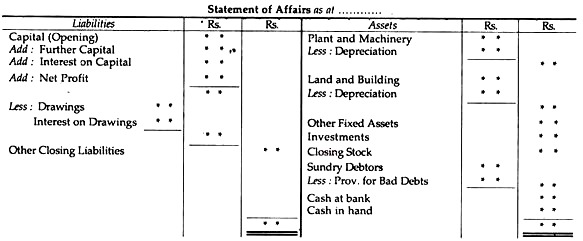STATEMENT OF AFFAIRS AND BALANCE SHEET DIFFERENCE
The Statement of Affairs and Balance Sheet are different names of records of assets and liabilities maintained by the different kinds of business organisation. It is necessary to know the Statement of Affairs and Balance Sheet difference to understand their meaning and adoption.
BALANCE SHEET
Balance Sheet is a statement which is prepared by the business houses to show the financial position of the concern at the end of the year. It contains the information regarding the assets, liabilities and capital invested in the business and prepared for the particular financial year. It shows the liquidity position, profitability position and the solvency position of the business house. The total of balance sheet is always equal. The format of Balance Sheet is as under:

STATEMENT OF AFFAIRS
Statement of Affairs is a statement, which shows assets on one side and the liabilities on the other on a particular date. The difference between the both sides is taken as capital. It is virtually a balance sheet of the concern prepared under single entry system. The format of Statement of Affairs is as follows:

STATEMENT OF AFFAIRS AND BALANCE SHEET DIFFERENCE
The Statement of Affairs and Balance Sheet difference is as follows:
| BASIS OF DIFFERENCE | BALANCE SHEET | STATEMENT OF AFFAIRS |
| DOUBLE/SINGLE ENTRY SYSTEM | It is prepared on the basis of books kept on double entry basis. | It is prepared on the basis of books kept on single entry system. |
| BASIS OF PREPARATION | It is based on the completely true and reliable data. | It is based on the balances of accounts, calculations, valuations, information and enquiry. |
| PURPOSE | Its purpose is to see the financial position. | Its purpose is to find out the capital |
| TRIAL BALANCE | Trial balance is prepared before preparing it. | Trial balance is not prepared before finding out the profit or loss. |
| CAPITAL | Capital is taken from the capital account in the ledger. | Excess of assets over liabilities is treated as capital |
| LEGAL RECOGNITION | Balance sheet can be presented in the court of law as evidence in case of disputes. | Statement of affairs is not accepted as evidence in the court of the law. |
| SUITABILITY | Balance sheet is suitable for all types of business being a part of scientific system. | Statement of is only maintained by the small or medium enterprises whom do not understand the importance of scientific system of accounting |
| TIMING OF PREPARATION | Balance sheet is prepared after the preparation of Profit and Loss Account | Statement of affairs is prepared before the preparation of statement of profit and loss. |
| DISAGREEMENT | Disagreement of the Balance Sheet indicates some omission or commission which can be rectified. | There is no question of agreement of the statement of affairs. The difference in amounts to capital. Hence omissions and commissions cannot be rectified. |
| VALUATION OF ASSETS AND LIABILITIES | The value of assets and liabilities shown in the balance sheet are those which are recorded in the ledger. | The value of assets and liabilities shown in the statement of affairs are mere estimates. |
| INFORMATION ABOUT CAPITAL | Balance sheet contains information about capital from accounting records. | In statement of affairs, capital is taken as balancing figures, being the difference between total assets and total liabilities. |
| ESTIMATION OF TRUE FINANCIAL POSITION | Balance Sheet shows the true financial position of a concern on particular date. | Statement of affairs shows estimated financial position of a concern on a particular date. |
| ARITHMETICAL ACCURACY | The tallying of balance sheet implies arithmetical accuracy of accounting books as it is prepared on the basis of trial balance. | The statement of affairs does not prove the arithmetical accuracy of accounting books as it is not prepared on the basis of trial balance. |
| RELIABILITY | Balance sheet is regarded as more reliable as it is based on double entry principles. | It is regarded as less reliable as it is based on incomplete records and estimates. |
| FOOTNOTES | Footnotes are prepared at the end of the Balance Sheet. | No footnotes are prepared at the end of Statement of Affairs. |
Thank you